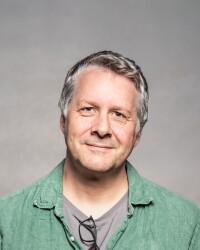Sixt Group
Cellular Morphodynamics
Immune cells zip through our bodies at high speeds to fight off infections and diseases. The Sixt group works at the interface of cell biology and immunology to investigate how cells are able to migrate through tissues.
Most cells in our bodies are stationary, forming solid tissues and encapsulated organs. One exception are leukocytes, immune cells essential for both the innate and adaptive immune responses to infections. Leukocytes migrate with extraordinary speed and are used by the Sixt group as a model to study cell migration. The group works at the interface of cell biology, immunology, and biophysics, and aims to identify basic mechanistic principles that are equally important for developmental processes and cancer cells. One research focus is how the cell’s internal skeleton generates and transduces the force to change shape, move the cell body and interact with other cells. The group also investigates how cells navigate along guidance cues, specifically how they orient their polarity axis in response to chemotactic gradients. In their work, the members of the Sixt group combine genetics, pharmacology, micro-engineering, surface chemistry, and advanced imaging approaches, as well as in vivo imaging techniques.
Team
Current Projects
Environmental control of leukocyte migration | Cellular force generation and transduction | Interpretation of chemo-attractive gradients
Publications
LI Z, Sixt MK. 2025. Cell migration: How animal cells run and tumble. Current Biology. 35(18), R890–R892. View
Ucar MC, Zane A, Alanko JH, Sixt MK, Hannezo EB. 2025. Self-generated chemotaxis of mixed cell populations. Proceedings of the National Academy of Sciences of the United States of America. 122(34), e2504064122. View
Dos Reis Rodrigues P. 2025. Coordination of protrusive forces in immune cell migration . Institute of Science and Technology Austria. View
Dos Reis Rodrigues P, Avellaneda Sarrió M, Canigova N, Gärtner FR, Vaahtomeri K, Riedl M, de Vries I, Merrin J, Hauschild R, Fukui Y, Juanes Garcia A, Sixt MK. 2025. Migrating immune cells globally coordinate protrusive forces. Nature Immunology. 26, 1258–1266. View
Canigova N. 2025. Adaptive strategies of dendritic cell migration in response to environmental cues. Institute of Science and Technology Austria. View
ReX-Link: Michael Sixt
Career
Since 2013 Professor, Institute of Science and Technology Austria (ISTA)
2014 – 2024 Executive Vice President, Institute of Science and Technology Austria (ISTA)
2010 – 2013 Assistant Professor, Institute of Science and Technology Austria (ISTA)
2008 – 2010 Endowed Professor, Peter Hans Hofschneider Foundation for Experimental Biomedicine
2005 – 2010 Group Leader, Max Planck Institute of Biochemistry, Martinsried, Germany
2003 – 2005 Postdoc, Institute for Experimental Pathology, Lund, Sweden
2003 MD, University of Erlangen, Germany
2002 Approbation in human Medicine
Selected Distinctions
2022 ERC Synergy Grant
2016 ERC Consolidator Grant
2014 EMBO Member
2013 European Biophysical Societies Association (EBSA) Young Investigator Medal
2013 Elected member of the Young Academy of the Austrian Academy of Sciences (ÖAW)
2012 Ignaz L. Lieben Award
2011 ERC Starting Grant
2011 FWF START Award
2008 Endowed Professor of the Peter Hans Hofschneider Foundation
2003 Novartis dissertation prize



















